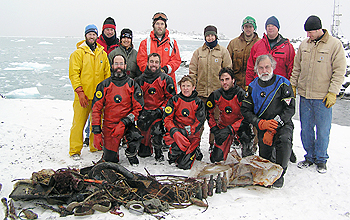News Release 07-044
Palmer Station, Antarctica Celebrates Earth Day With an Underwater Clean Up
April 20, 2007
This material is available primarily for archival purposes. Telephone numbers or other contact information may be out of date; please see current contact information at media contacts.
Residents at Palmer Station, a year-round U.S. research station on the Antarctic Peninsula, removed old debris from the sea floor near the station in late April 2007, as a part of an annual Earth Day clean up.
In the early days of Antarctic exploration, in the first decades of the 20th century, expeditions were largely unregulated and free to dispose of wastes as the leaders saw fit. In the latter half of the century, following renewed efforts to explore the polar regions that were sparked in part by worldwide interest in the continent and a burgeoning, global environmental consciousness, nations began to develop environmental policies for Antarctica as well as efforts to mitigate past environmental harm.
The international Antarctic Treaty, to which the United States is a signatory, contains a Protocol on Environmental Protection that designates Antarctica as a "natural reserve, devoted to peace and science," and sets forth basic principles and detailed, environment-related obligations applicable to human activities in Antarctica.
The National Science Foundation (NSF) oversees the U.S. Antarctic Program, which manages three year-round stations on the southernmost continent and coordinates all U.S. scientific research there. The White House has designated NSF as the lead U.S. Agency for the International Polar Year 2007-2008, a concerted global research effort in the polar regions.
-NSF-
Media Contacts
Peter West, NSF, (703) 292-7761, email: pwest@nsf.gov
Related Websites
The U.S. government International Polar Year (IPY) portal: http://ww.ipy.gov
The Palmer Station Long Term Ecological Research (LTER) site: http://www.lternet.edu/sites/pal/
The U.S. Department of State's Antarctic Treaty Web site: http://www.state.gov/g/oes/ocns/c6528.htm
The International Antarctic Secretariat's Web site has links to the Environmental Protocol: http://www.ats.aq
The U.S. National Science Foundation propels the nation forward by advancing fundamental research in all fields of science and engineering. NSF supports research and people by providing facilities, instruments and funding to support their ingenuity and sustain the U.S. as a global leader in research and innovation. With a fiscal year 2023 budget of $9.5 billion, NSF funds reach all 50 states through grants to nearly 2,000 colleges, universities and institutions. Each year, NSF receives more than 40,000 competitive proposals and makes about 11,000 new awards. Those awards include support for cooperative research with industry, Arctic and Antarctic research and operations, and U.S. participation in international scientific efforts.
Connect with us online
NSF website: nsf.gov
NSF News: nsf.gov/news
For News Media: nsf.gov/news/newsroom
Statistics: nsf.gov/statistics/
Awards database: nsf.gov/awardsearch/
Follow us on social
Twitter: twitter.com/NSF
Facebook: facebook.com/US.NSF
Instagram: instagram.com/nsfgov



